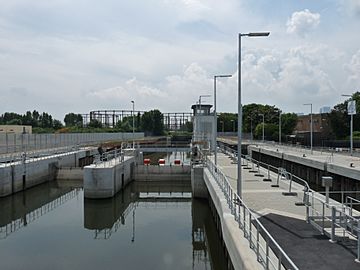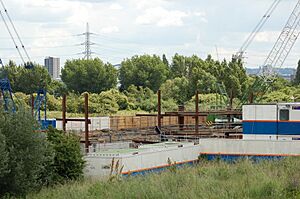Three Mills Lock facts for kids

Three Mills Lock
|
|
| Waterway | River Lee (Bow Back Rivers) |
|---|---|
| County | Tower Hamlets Greater London |
| Operation | Canal & River Trust |
| First built | 2008–09 |
| Length | 62 metres (203 ft) |
| Width | 8 metres (26.2 ft) |
| Fall | tidal |
| Coordinates | 51°31′44″N 0°00′16″W / 51.528797°N 0.004356°W |
The Three Mills Lock, also known as the Prescott Lock, is a special structure on the Prescott Channel in London. It's located on the River Lea, which is a well-known waterway. This lock was built to help boats move easily along the river.
The project was managed by British Waterways, and the lock officially opened in June 2009. It helps control the water level in the Bow Back Rivers area. This makes it easier for boats, like leisure boats, water taxis, and even floating restaurants, to use the river. It also helps large barges carry building materials for big projects, like the 2012 Olympics.
Contents
How Three Mills Lock Works
Three Mills Lock was built on the Prescott Channel. This channel was first made in the 1930s to help prevent floods and create jobs. It used to have a sluice, which is a gate that controls water flow. This old sluice stopped working by the 1960s.
When the sluice was removed, the rivers became tidal again. This meant the water level changed a lot with the tides. At low tide, there wasn't enough water for boats. At high tide, the water was too high, and boats couldn't fit under bridges. This made it hard for boats to travel.
Why a New Lock Was Needed
The area around the River Lea was chosen for the main stadium of the 2012 London Olympics. To help with building the stadium, it was important to fix the river channels. This would allow construction materials to be brought in by barges.
So, a new lock and sluice were designed for the Prescott Channel. Another sluice was added on the Three Mills Wall River. This stopped the tide from flowing backward through the old mills. The new lock helps keep the water level stable, making it safe for boats to pass through.
Lock Size and Features
The new lock is about 62 metres (203 ft) long and 8 metres (26.2 ft) wide. It is deep enough for two large barges, each carrying about 350 tonnes of goods. This is much more than the older locks on the nearby Lee Navigation, which can only handle barges of about 120 tonnes.
The lock uses special gates called hydraulic sector gates at both ends. These gates can handle the changing water levels caused by the tide. The structure also has two large rising radial gates. These are used to control floods in the Bow Back Rivers.
The lock also includes a footbridge for people to walk across. There's also a special fish pass, which helps fish move along the river. The project also improved the paths next to the river, known as towpaths.
What the Lock Changed
Building the Three Mills Lock, along with the Three Mills Wall River Weir, stopped the tide from entering this part of the Bow Back Rivers. This means the river here is no longer tidal.
The lock was built so that barges from big building projects, like the London 2012 Olympics and Stratford City, could use it. They could take away waste and bring in building materials. These barges travel directly into Bow Creek and then to the River Thames. The stable water level created by the lock might even allow the old Three Mills tidal mill to work again.
A Quick Look Back
During the construction of the lock, a large old bomb from World War II was found in June 2008. It was safely removed in a controlled way.
The lock officially opened on June 5, 2009. It started working with a limited number of boats. Even though it was built for large projects, it was expected to be used for about "one barge a week" at first.
Getting There
If you want to visit Three Mills Lock, you can use public transport.
- The nearest London Underground stations are West Ham and Bromley-by-Bow.
- The nearest Docklands Light Railway stations are Bow Church and Pudding Mill Lane.


